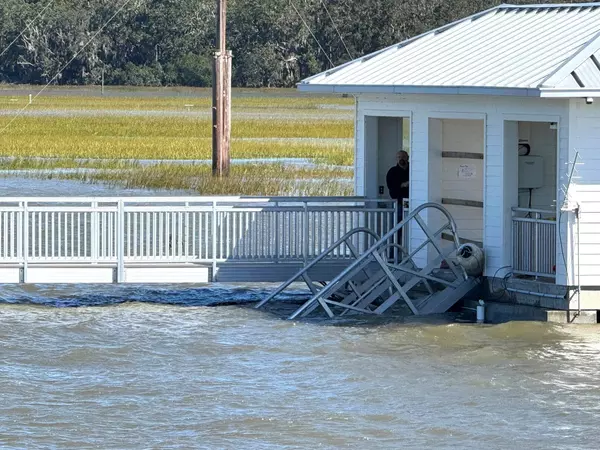
Ukraine has accused Russian forces of destroying another dam with the aim of slowing a counteroffensive launched by Kyiv.
As rescue and relief efforts entered their seventh day for victims of the destruction of the Kakhovka hydroelectric station in Kherson region, the Russian military was accused of blowing up a much smaller dam along the Mokri Yaly River, which has become the most successful axis so far for Ukraine’s advances in western Donetsk.
Ukrainian forces have moved along both sides of the river, southwards from the town of Velyka Novosilka, declaring the liberation of a string of villages: Blahodatne on the east bank; and Neskuchne, Makarivka and Storozheve on the west side.
On Monday night, Ukraine’s deputy defence minister, Hanna Maliar, said three other settlements further west along the frontline – Novodarivka, Levadne in eastern Zaporizhzhia, and Lobkove in western Zaporizhzhia – had also been taken by Ukrainian forces.
The armed forces have published pictures of their units holding up flags in what were claimed to be the recaptured villages. The claims could not be independently verified, but Russian military bloggers confirmed the Ukrainian advance and reported heavy fighting overnight and on Monday morning for the next village along, Urozhaine, on the east bank of the river, straddling the road south-east towards Mariupol.
Valeriy Shershen, a Ukrainian military spokesperson for that sector of the front, told the Ukrainska Pravda news agency that a dam upstream along the Mokri Yaly had been blown up by occupation forces, causing flooding on both banks. Shershen said the Russian aim had been to “slow down Ukraine’s counteroffensive” but claimed it had failed. The dam appears to have been at the village of Klyuchove but its destruction could not be independently verified.
On Sunday, the deputy defence minister, Hanna Maliar, celebrated the announcement of the latest village to fall, Storozheve, thanking the marines who recaptured it and adding: “It will be the same with every settlement until we liberate all Ukrainian land.”
Ukrainian officials have otherwise been tight-lipped about the counteroffensive, other than to note small territorial gains around Bakhmut, on the northern Donetsk front. The villages along the Mokri Yaly River mark the first settlements to be liberated after a week of counteroffensive, and Kyiv has made much of the capture of these small villages, aware that Ukrainians are nervous after seeing videos of wrecked Ukrainian tanks and armoured vehicles from failed assaults farther west along the line, in Zaporizhzhia.
Ukrainian military officials have privately called for patience and pointed out they had so far not committed the bulk of Kyiv’s 12 brigade-strong western-armed assault force to the battle.
“By the way, we didn’t move our main forces yet,” a Ukrainian officer texted from the southern front. “So there are grounds to believe in the best.”
Kyiv is frustrated that western capitals have so far not pronounced verdicts on responsibility for the destruction of the Kakhovka dam. Officials have pointed out that it would have been almost impossible to cause that amount of damage from external shelling to a structure designed to withstand a tactical nuclear bomb, that it must therefore have been blown up from the inside, and that the Russians had complete control of the Kakhovka hydroelectric station at the time. The Ukrainian security service has published an audio clip of what it said was two Russian soldiers talking about how a Russian sabotage unit had been responsible.
Maliar said that in the wake of the disaster, Russia was moving its forces from the left (eastern and southern) bank of the Dnipro in Kherson region to other parts of the frontline. She suggested Russian forces had blown up the dam to make it much harder for Ukrainian assault troops to cross the flooded lower Dnipro, and therefore shorten the front they had to defend.
Downstream of the wrecked dam, Ukrainian authorities said the flood waters were beginning to recede at up to 5cm an hour. Upstream meanwhile, the reservoir continued to drain, leaving vast expanses of mud flats and dead fish. According to officials in Kyiv, more than 72% of the reservoir’s capacity, 14,395 cubic kilometres of water, had already been lost. In Nikopol, a town on the Ukrainian-controlled right (northern) bank of the Dnipro across from the occupied Zaporizhzhia nuclear power station, the water had receded so far that it was impossible to determine its level.
Ukraine’s environment minister, Ruslen Strilets, said that despite the disappearance of the reservoir, the nuclear plant had sufficient water to keep its reactor cores and spent fuel cool and prevent a meltdown.
“Regarding the power plant, the water level in the plant’s ponds is stable and sufficient to meet the plant’s needs. The situation is now under control,” Strilets said in a television interview.
Rafael Mariano Grossi, the director general of the International Atomic Energy Agency (IAEA), is due in Ukraine this week hoping to visit the plant. Grossi said on Sunday that his experts needed to check discrepancies in measurements of water levels of the reservoir.







